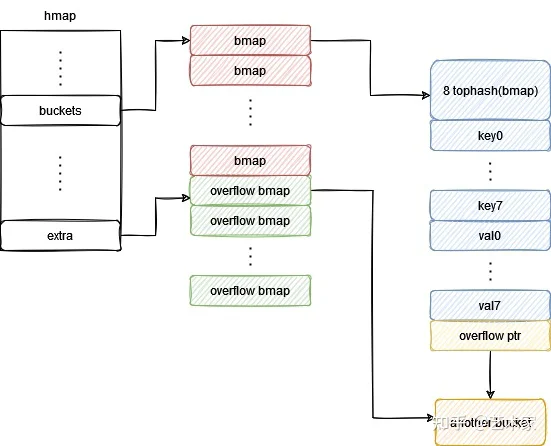本文主要从源码角度去理解golang的map。map是golang的哈希表,golang使用拉链法来解决哈希冲突。
Data Structure
首先我们看一下golang里面map的数据结构,map的核心数据结构是hmap,bmap是拉链式哈希表中的桶(bucket):
// A header for a Go map.
type hmap struct {
// Note: the format of the hmap is also encoded in cmd/compile/internal/gc/reflect.go.
// Make sure this stays in sync with the compiler's definition.
count int // # live cells == size of map. Must be first (used by len() builtin)
flags uint8
B uint8 // log_2 of # of buckets (can hold up to loadFactor * 2^B items)
noverflow uint16 // approximate number of overflow buckets; see incrnoverflow for details
hash0 uint32 // hash seed
buckets unsafe.Pointer // array of 2^B Buckets. may be nil if count==0.
oldbuckets unsafe.Pointer // previous bucket array of half the size, non-nil only when growing
nevacuate uintptr // progress counter for evacuation (buckets less than this have been evacuated)
extra *mapextra // optional fields
}
type mapextra struct {
overflow *[]*bmap
oldoverflow *[]*bmap
nextOverflow *bmap
}
// A bucket for a Go map.
type bmap struct {
// tophash generally contains the top byte of the hash value
// for each key in this bucket. If tophash[0] < minTopHash,
// tophash[0] is a bucket evacuation state instead.
tophash [bucketCnt]uint8
// Followed by bucketCnt keys and then bucketCnt elems.
// NOTE: packing all the keys together and then all the elems together makes the
// code a bit more complicated than alternating key/elem/key/elem/... but it allows
// us to eliminate padding which would be needed for, e.g., map[int64]int8.
// Followed by an overflow pointer.
}
每个桶最多放8个元素,注意这个bmap结构体,它只存了这个8个key的tophash,用于加速遍历,真正的key和val是紧凑地排在bmap结构体后面的,当要访问元素时会根据offset去访问。
大致结构图如下:

Init map
接着我们看下map是怎么被初始化的,我们平常会用 m := make(map[string]int) 去初始化一个map,在编译阶段做type check之后生成中间代码时根据情况会用 makemap_small/ makemap 去代替:
m := make(map[string]int) //makemap_small,初始化一个空的hmap
m := make(map[string]int,10) //makemap
在makemap中,会根据传入的hint(预估大小)调用makeBucketArray分配适当数量的buckets,数量是2的指数。如果数量大于16,数据量可能会比较多,会分配适量的overflow buckets;否则不分配,节约内存。这些overflow buckets会在正常bucket空间不够时会分配给需要的bucket,通过setoverflow函数将bucket末尾的指针指向一个overflow bucket。
好了,我们大致知道map长啥样了,下面我们聊一下golang map的相关操作:读(Read),写(Write),扩容(Expand),删除(Delete),这些功能的主要实现都在src/runtime/map.go里面。其中扩容不是我们要操作的,是我们在写入或者删除元素时map自己操作的。
Read
当我们使用map[key]访问map中的某一个元素的时候,在代码编译阶段会用mapaccess1/mapaccess2替换:
v:=hashmap[key] //使用mapaccess1
v,ok:=hashmap[key] //使用mapaccess2
两个函数实现方式差不多,mapaccess2会多返回一个bool变量用于告诉这个key是否存在于map之中。下面我们截取mapaccess1函数的部分片段分析一下读取map的流程
由于map并发读写不是线程安全的,如果map正在被写入,会抛出一个异常:
if h.flags&hashWriting != 0 {
throw("concurrent map read and map write")
}
接着计算key的hash值,取hash值的最低几位去找对应的bucket:
hash := t.hasher(key, uintptr(h.hash0))
m := bucketMask(h.B) // m = uint8(1)<<B - 1
b := (*bmap)(add(h.buckets, (hash&m)*uintptr(t.bucketsize)))
在遍历bucket中的元素之前,我们要看一下map是否在扩容(后面会讲),以及要访问的bucket是否在迁移;如果有oldbucket,表明map正在扩容,由于map的扩容是渐进式的,部分old bucket中的元素可能还没有迁移到新的bucket中去,通过evacuated函数看一下bucket是否在迁移过程中,如果还没迁移,我们就使用old bucket:
if c := h.oldbuckets; c != nil {
if !h.sameSizeGrow() {
// There used to be half as many buckets; mask down one more power of two.
m >>= 1
}
oldb := (*bmap)(add(c, (hash&m)*uintptr(t.bucketsize)))
if !evacuated(oldb) {
b = oldb
}
}
//evacuated函数
func evacuated(b *bmap) bool {
h := b.tophash[0]
return h > emptyOne && h < minTopHash
}
然后计算key的tophash(高8位),然后先和bucket以及其overflow bucket中的tophash比较,相等才去比较整个key是否相等,否则continue省去后面的计算步骤。可以看出tophash在这里起到一个加速遍历的作用:
top := tophash(hash)
bucketloop:
for ; b != nil; b = b.overflow(t) {
for i := uintptr(0); i < bucketCnt; i++ {
if b.tophash[i] != top {
if b.tophash[i] == emptyRest {
break bucketloop
}
continue
}
k := add(unsafe.Pointer(b), dataOffset+i*uintptr(t.keysize))
if t.indirectkey() {
k = *((*unsafe.Pointer)(k))
}
if t.key.equal(key, k) {
e := add(unsafe.Pointer(b), dataOffset+bucketCnt*uintptr(t.keysize)+i*uintptr(t.elemsize))
if t.indirectelem() {
e = *((*unsafe.Pointer)(e))
}
return e
}
}
}
如果没有找到key,返回一个zero object,也就是golang中的零值:
- false for booleans
- 0 for numeric types
- "" for strings
- nil for pointers, functions, interfaces, slices, channels, and maps
return unsafe.Pointer(&zeroVal[0])
//zero object
const maxZero = 1024 // must match value in cmd/compile/internal/gc/walk.go:zeroValSize
var zeroVal [maxZero]byte
Write
map的写入是由 mapassign实现的
首先看在写之前做了哪些操作:会置一个写的标记位;如果没有对应的bucket,会创建一个bucket;如果bucket正在扩容(有oldbucket),并且当前的bucket是一个old bucket,那么会将old bucket中的元素迁移到新的bucket中:
h.flags ^= hashWriting
if h.buckets == nil {
h.buckets = newobject(t.bucket) // newarray(t.bucket, 1)
}
again:
bucket := hash & bucketMask(h.B)
if h.growing() {
growWork(t, h, bucket) //调用evacuate函数迁移
}
b := (*bmap)(unsafe.Pointer(uintptr(h.buckets) + bucket*uintptr(t.bucketsize)))
接下来和mapaccess的bucketloop差不多,如果有对应的key则更新
如果没有key并且map不在扩容过程中,在下面两个条件下会进行扩容:
- 达到一定的负载因子
- 过多的overflow buckets
扩容完成后然后再走一遍之前的流程:
// If we hit the max load factor or we have too many overflow buckets,
// and we're not already in the middle of growing, start growing.
if !h.growing() && (overLoadFactor(h.count+1, h.B) || tooManyOverflowBuckets(h.noverflow, h.B)) {
hashGrow(t, h)
goto again // Growing the table invalidates everything, so try again
}
最后写入key,value
Expand
当map触发扩容的时候会调用hashGrow函数,如果是overflow buckets过多则等量扩容,如果是负载因子较高则翻倍扩容。扩容会分配新的内存空间,扩容完成后,让oldbucket指向原来的桶, bucket指向新创建的桶:
bigger := uint8(1)
if !overLoadFactor(h.count+1, h.B) {
bigger = 0
h.flags |= sameSizeGrow
}
oldbuckets := h.buckets
newbuckets, nextOverflow := makeBucketArray(t, h.B+bigger, nil)
注意这里只是扩容,但是还没有迁移数据,map的数据迁移是渐进式的,比如之前提到的写入操作时会触发growWork迁移对应的桶中的数据,还有之后的删除操作。
这种渐进式迁移数据的好处是,如果map中的数据较多,一次迁移所有数据会导致系统卡顿较慢。
迁移是通过evacuate 实现的,在桶翻倍时需要分流。比如4个桶变成了8个桶,那么hash值为3和7的key之前在3号桶,扩容后key=7的要分流到7号桶,感兴趣可以看看该函数的实现。
Delete
删除和写入类似,当我们使用delete(map,key)的时候,编译期间会转换成runtime中的对应函数,比如mapdelete, 它的流程和mapassign差不多,期间也会对相应的桶做数据迁移。
聊完了map的实现原理,我们接下来再聊一聊在使用map时的注意事项吧,可能对我们工作更有帮助:
用for range遍历map
我们在用for range去遍历map的时候,编译器会用 mapiterinit 和 mapiternext 去替代。返回的key顺序可能是随机的,因为如果有扩容,会发生rehash,key的顺序会发生变化。所以我们的程序里最好不要有逻辑依赖遍历map返回key的顺序。
map作为参数传入函数
看makemap函数的返回值,map本身其实是一个*hmap指针:
func makemap(t *maptype, hint int, h *hmap) *hmap
作为函数参数传递时传的就是hmap的地址,所以我们在函数内增删改传入的map时也会改变函数外这个map本身的
哪些类型能作为key
只要类型能比较相等就行:
| 能作为key的类型 | 不能作为key的类型 |
|---|---|
| Bool | Slice |
| Numeric | Map |
| String | Function |
| Pointer | |
| Channel | |
| Interface | |
| Struct | |
| 只包含上述类型的数组 |
为什么map并发读写不是线程安全的
看了之前的map实现细节也就知道了,写入时可能会出现扩容和迁移数据,没有加锁也没有原子操作,这时一个读的线程进来,可能会出现意外的结果导致这个读线程无法正确执行。其实slice并发读写也不是线程安全的,它也涉及到扩容和数据迁移并且没有锁和原子操作;只不过对于map的并发读写,官方在代码里就直接给你throw一个异常,所以我们印象更深刻。如果要并发读写map,要么自己加锁,要么用官方提供的sync.Map
